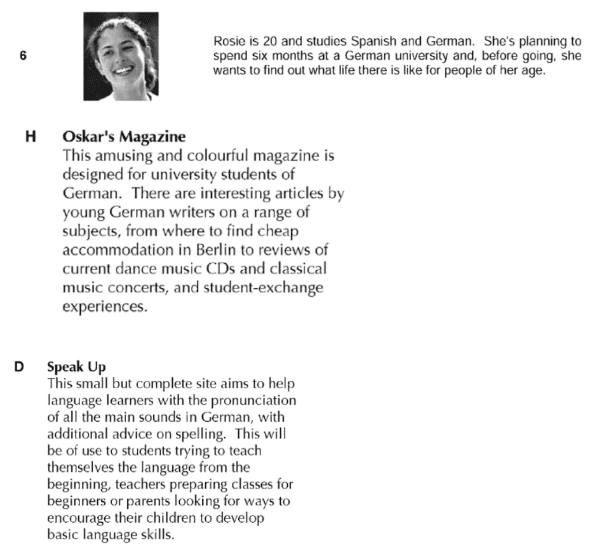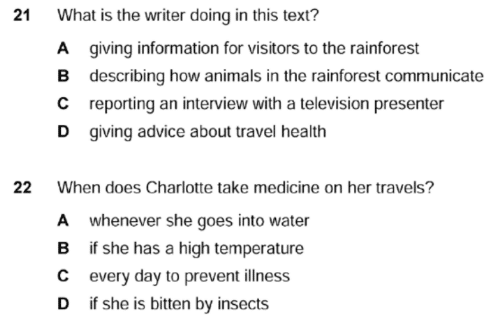Top Tips for Preparing for the Cambridge PET Reading Questions (Parts 1-5)
Without proper preparation the reading part of the PET exam can be very tricky. As we have mentioned in other blog posts, you will need to be familiar with the grammar and vocabulary from a B1 syllabus to have a chance of passing. You will also need to develop good exam techniques to answer these questions effectively and efficiently.
Here are some of the techniques that we work on with our students at Atlas.
How to do part 1 (three-option multiple choice)
For this part, you will be given 5 very short texts. They could be signs, messages, postcards, notes, emails, labels, etc.
Here is an example:

You will be tested mostly on functional language and synonyms. Remember, functional language is language that delivers a type of message.
If we look carefully at the options we may be given we can predict what language we might see:
Signs – warnings and requests
Messages – requesting, apologising, ordering
Postcards – describing a situation, informing
Notes – offering information, asking for information
Emails – apologising, persuading, suggesting, recommending
Labels – warning, giving advice.
These are only some of the options which may appear, but pay attention to what the message is. To find out more information on functional messages, see our earlier blog post on PET writing.
How to do part 2 (matching)
In this part, you are given 5 items in the form of descriptions of people and you have to match these to eight short descriptions. This means you will have 3 extra short descriptions that you won’t need.
It is also important to remember that no text can be the answer to two questions. Also when choosing your answer, check that the texts match on all points.
Here is a typical question and two possible answers. You need to match the person to the description of the website that they’ll need:

Both options mention German. However, Rosie says that she wants to find out what life is like there. Text D (Speak Up), only speaks about the language of German and how it sounds. Whereas Text H (Oskar’s Magazine), talks about what life is like in Berlin and what you can do there. Text H is therefore the correct answer.
These are the typical tricks you may find in the exam, so make sure all the information is there before you choose the correct answer.
How to do part 3 (True/False)
You will be given a long text with ten true/false statements for you to decide on.
The first thing you will need to do here is underline the keywords from each sentence and find them in the text. Also, when you find the information, it is a good idea to make sure you number where you found it in the main text.
An extremely useful but easy and effective way to do this part of the test is to turn the statements into questions.
For example:
11. It is essential to book a place before you join a London Walk.
12. The guide can be recognised because of the papers he is carrying
13. You can tour the Houses of Parliament free following the walk.
If you change these 3 statements into questions, they will be:
11. Is it essential to book a place before you join a London Walk?
12. Can the guide be recognised because of the papers he is carrying?
13. Can you tour the Houses of Parliament free following the walk?
As you can see, this turns the questions into yes/no answers. This should make it easier to see if it’s true or false.
How to do Part 4 (four-option multiple choice)
In part 4 you will be given a long text with multiple choice questions. Generally, the text will be about someone’s attitude or opinion, and what their purpose is.
You may have to read for specific information or to get the general idea of what they are saying.
Here are two typical questions from this part:

We can see in question 21 that you need to get the general idea from the text. What is the writer doing? However, in question 22, we need to find specific information – When does Charlotte take medicine?
It’s important to recognise the type of question you are being asked so you don’t waste time looking for specific information when you need to focus on the general idea. And you don’t focus on the general idea when you should be looking for some specific information.
Another good tip is to use the process of elimination. This is where you mark off the answers that you are sure are not correct. For example, you know A and B are not the answers. You will be left with two options to choose from. This obviously now makes it easier to choose (or even guess) the correct answer.
How to do Part 5 (four-option multiple choice cloze)
In this part of the PET test you have to fill in gaps in a text. You are given four options for each gap. You are tested on both grammar and vocabulary. It is very important to read what comes before and what goes after each gap.
Let’s have a look at an example of task 5 taken from the handbook. First, do questions 26 – 30 yourself. Try not to look at the answers further down the page:

Now let’s have a look at the answers and why they were correct.
26. B first is correct. Just and already are usually used with the present perfect. Once cannot be correct because it means that it was popular then and never again.
Here are two typical questions from this part:
27. D decided is correct. The others are followed by different prepositions or don’t need a preposition (imagine + doing, suppose + to do, dream + of doing). This is an example of how important it is to read after the gap to help you decide on the correct answer.
28. A realised is correct. In this example, it expresses that photographers discovered something that they didn’t know before. They did not remember information from the past, persuade someone to do something, or wonder about something that might happen.
29. B so is correct. But and although are used to express contrasts and since can be used to express a reason. In this example we need to express a result, so ‘so’ is the correct answer.
30. C of is correct. This is part of a collocation i.e., sell + amount + of + something. The other answers can’t be used.
As you can see from the examples above, you will need to have good knowledge of both grammar and vocabulary. So make sure you are familiar with a full B1 syllabus. This will help you get those marks you need to get a top grade in the exam.
These tips and suggestions will hopefully put you on the right track for preparing for the Cambridge PET reading parts . As we’ve said before, though, you will learn to read better by reading more. So, when preparing for the exam read a wide range of texts and talk about what you read with others. This will help make reading fun.
If you haven’t started preparing and using the techniques in the above post, we’d love to help you get started.
Features of our preparation are:
- Experienced Cambridge preparation teachers who know and understand the exam.
- Focus on improving skills and exam technique.
- All Cambridge First courses are developed and supervised by our Academic Manager who is a Cambridge examiner.
- Full mock exam prepared and corrected to Cambridge standards.
